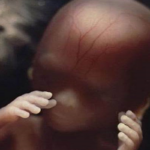Blog Post
What I saw at the abortion
By Jonathon Van Maren
This is the Epilogue of my 2017 book Seeing is Believing: Why Our Culture Must Face the Victims of Abortion. It can be ordered here.
In January of 1976, an essay by Dr. Richard Selzer was published in Esquire magazine titled, “What I Saw at the Abortion.” Selzer did not consider himself to be religious—he had “no overriding religious posture” and was “enlightened,” in his own words—and he was certainly not a member of the pro-life movement. Far from being a man who recoiled at the sight of blood, Dr. Richard Selzer was a professor of surgery at Yale University who had seen countless gory procedures, awful diseases, and malignant infections. And yet, the essay he wrote after he watched one of his colleagues perform what was supposed to be a “routine” 24-week abortion bears witness to the banal horrors we have come to accept as a matter of fact:
In the room we are six: two physicians, two nurses, the patient, and me. The participants are busy, very attentive. I am not at all busy—but I am no less attentive. I want to see.
I see something!
It is unexpected, utterly unexpected, like a disturbance in the earth, a tumultuous jarring. I see something other than what I expected here. I see a movement—a small one. But I have seen it. And then I see it again. And now I see that it is the hub of the needle in the woman’s belly that has jerked. First to one side. Then to the other side. Once more it wobbles, is tugged, like a fishing lined nibbled by a sunfish.
Again! And I know!
It is the fetus that worries thus. It is the fetus struggling against the needle. Struggling? How can that be? I think: that cannot be. I think: the fetus feels no pain, cannot feel fear, has no motivation. It is merely reflex. I point to the needle. It is a reflex, says the doctor…
A reflex, the doctor says. I hear him. But I saw something. I saw something in that mass of cells understand that it must bob and butt. And I see it again! I have an impulse to shove to the table—it is just a step—seize that needle, pull it out. We are not six, I think. I think we are seven.
Something strangles there. An effort, its effort, binds me to it. I do not shove to the table. I take no little step. It would be madness. Everyone here wants the needle where it is. Six do. No, five do…
I know. We cannot feed the great numbers. There is no more room. I know, I know. It is woman’s right to refuse the risk, to decline the pain of childbirth. And an unwanted child is a very great burden… And yet, there is the flick of that needle. I saw it. I felt—in that room, a pace away, life prodded, life fending off. I saw life avulsed—swept by flood, blackening—then out…
Does this sound like an argument? I hope not. I am not trying to argue. I am only saying I’ve seen. The flick. Whatever else may be said in abortion’s defense, the vision of that other defense will not vanish from my eyes. What I saw I saw as that: a defense, a motion from, an effort away. And it has happened that you cannot reason with me now. For what can language do against the truth of what I saw?[i]
In spite of a tumult of arguments for the pro-choice position, Dr. Richard Selzer saw, and what he saw changed him forever. He saw a tiny human being feebly trying to fend off the invaders who had come to destroy him, and failing. That awful truth, when seen, is so powerful that it can change the course of peoples’ lives. Photographs of the sad remains of little girls and little boys can overpower mere arguments and feeble philosophies and drive home a realization that can turn men and women from committing the same awful crime against their own children.
Because seeing is believing.
[i] Richard Selzer, “What I Saw at the Abortion,” Esquire, January, 1976, 66-67









The horrendous truth is that one can never unsee what one has seen. It is burned on one’s retina forever. Evil causes a disconnect between what is seen and how our heart reacts. May hearts be opened and may human compassion pour forth from our very soul and end this human holocaust once and for all.
The sad truth is that there are actually people out there who have been so severely seared, that even in the face of seeing, they refuse to ‘see’.